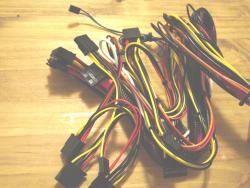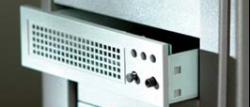2003 Power Supply Roundup Part II: Better Faster Cheaper
by Kristopher Kubicki on July 31, 2003 1:58 PM EST- Posted in
- Cases/Cooling/PSUs
We saw the elegant and simple TruePower a few months ago, so we were pretty excited to see if Antec had any other products in the PSU industry we could include in our roundup. The TrueControl 550 is Antec’s highest end product, allowing fan control through a designated 5.25” bay controller. Memories of our Sound Blaster LiveDrive instantly came to mind.
The controller itself is very utilitarian looking, but it seems to get the job done. For all Antec's worth, they probably could have made the controller look a little more appealing.
Antec clearly spared no expense on the 550W TrueControl, and we noticed this is a very different supply from the 430W TruePower we saw several months ago. Several interesting things caught our attention. First, this is the only power supply we have seen with an external rear molex connector. We are not really sure why, but there must be some applications for such a feature.
Also present were black molex connectors. Almost every power supply we have seen to date uses white or clear molexes. Besides the 7 standard molex connectors, the unit comes with 2 fan only connectors (also present on the TruePower 430W). The forward bay allows for control on the internal fans, as well as the fans along these designated fan control rails as well. A very interesting feature, but it is perhaps limited in usefulness. A motherboard fan control connector is also included.
Also, the TrueControl 550 comes with dedicated molexes for fan control. The 5.25" bay is capable of controlling these fans through the power supply. This is defiantly a nice touch since we have previously questioned whether the dedicated fan molexes were worthwhile.
Again, Antec makes the point of demonstrating that the TrueControl 550 has separate lines for each of its 3 main rails. The real element that separates this power supply from the ThermalTake PurePower is the variable voltage on the fan controller. Using the included tool, the unit allows you to modify your voltage settings to adjust within %5 each of the three main rails (+12V, +3.3V, +5V). While this is incredibly useful if you are a die hard overclocker, it can be very hazardous if used incorrectly. For example, underpowering your +12V rail might result in underpowering your P4 or video card, which will eventually damage your components if not careful.
Wattages
|
|
3.3V |
5V |
12V |
-12 |
-5 |
+5vsb |
combined theoretical |
actual combined |
advertised total |
|
Antec TrueControl 550 |
105.60 |
200.00 |
288.00 |
12.00 |
2.50 |
10.00 |
- |
- |
554.50 |
On paper, the theoretical combined 530W maximum impresses us. Remember, the unique feature about a lot of Antec power supplies is that they have separate rails for each of the three main power lines. The advertised +12V rail comes in very respectably at 288W. This power supply will work well for the hungriest of AMD or Intel systems. Die hard overclockers will enjoy the control over each rail, which is also offered on the PC Power and Cooling TurboCool. Be warned though, variable pot controls can seriously compromise your system's stability.
Unfortunately, this supply also weighs in as one of our most expensive units. This is somewhat against the grain of our last Antec power supply which was priced very moderately. For $130 you get the fan controller, and a lot of extras. The dedicated power rails are worth it for a serious overclocker, so albeit expensive, the TrueControl 550 still does not disappoint.












70 Comments
View All Comments
Anonymous User - Thursday, August 7, 2003 - link
With each review unit, show a picture of the insides. Some of us can tell the design differences by looking at a picture.Claimed efficiency is a selling feature. An efficient unit doesn't need as much cooling air, and is easier on the electric bill.
See if you can rent a load tester. Do a current ramp on the rails, to see what kind of dynamic response the units have. On +12V, this would happen when going from stop-grant, to 100% computing load. Power supplies overshoot when this happens.
Your memory test is meaningless. A motherboard voltage regulator filters the rails, so this is unlikely to be a source of trouble with memory. Radiated emissions (E or M field) can influence circuitry, but you should use a spectrum analyser plus pickup coil to get some idea.
Another emission test, is EMI coming out of the power supply via the power cord. For example, my Truepower interferes with Channel 4 on my TV set. This means the common mode EMI filter at the input to the PS is insufficient. Consult with an EMI expert on how to measure this.
Overvoltage and overcurrent protection were not mentioned. Some units don't do it on all high output rails. Some don't do it at all. One unit had a circuit breaker on the back, which is a significant difference worth mentioning. The tolerance on some protection circuits is so sloppy, that the unit will burn before it trips.
No review I've read so far has mentioned this clause in the ATX spec which is available from formfactors.org "The maximum short-circuit energy in any output shall not exceed 240 VA, per IEC 60950 requirements."
For the high power models which violate this fire containment requirement, will my house insurance cover me if my PC lights the house on fire ?
This requirement could be met by using separate outputs for +12 to motherboard and +12 to drives.
Fire danger is a good reason not to use acrylic windows on a PC case.
Anonymous User - Wednesday, August 6, 2003 - link
"Several months ago, we published our first power supply roundup."Do you mean this one from 42 months ago? :)
http://www.anandtech.com/showdoc.html?i=1128&p...
Anonymous User - Wednesday, August 6, 2003 - link
pretty sweet review,the noise results were v interesting - does this mean that any computer without ECC memory is inherantly unstable?
Anonymous User - Wednesday, August 6, 2003 - link
Hm... The memory test makes me wonder. Two things basically:1) How do you know the errors really are caused by the PSU? The figures suggest that it is, but have all other possible sources been ruled out? The numbers are low, and could be random variations for all I know.
2) If memory content changes during 6 hours without read or write (and only the normal refresh), what does that mean for reliability on computers with up-times of months or even years? On the other hand, this could be the reason servers have ECC memory...
Anonymous User - Wednesday, August 6, 2003 - link
Without wishing to be defamatory, Q-Tec units suck. In life you get what you pay for. These units have no safety circuits at all. They are of 'unlimited' design and the only control mechanism is when a component blows up. In so doing it may well take your mobo etc with it. Their top of the range unit provides less power on the 3.3v and 5v rails that most quality 300 watt units.Anonymous User - Wednesday, August 6, 2003 - link
You show the 'actual combined' on the huge EG651 Enermax at 200 watts. This is less than some 300 watt units. Why did you not highlight this? And why do Enermax put a 651 number on a 550 watt unit? Everyone else uses the number as the rated power figure.Goi - Wednesday, August 6, 2003 - link
I'd like to see reviews of Heroichi(HEC), aka Compucase, as well as Enlight, Topower and if possible Verudium PSUs. Also, the "ripple" measurements were only taken over a 30-60s duration, and only at full load. Other than the fact that what was measured isn't called "ripple" but actually the voltage fluctuation on the individual voltage rail, 30-60s sounds like a very short time window, and this should be measured both at idle and load conditions, since we all know that voltages tend to fluctuate when going from idle to load conditions and/or vice versa.Anonymous User - Wednesday, August 6, 2003 - link
How about Topower PSU's? I have seen a review elsewhere that says their 400W has similar performance to Enermax's (at a much lower price), but it was nowhere near as in-depth as your article.Anonymous User - Tuesday, August 5, 2003 - link
Antec 330 true power's performance on 12v is not enough for a P4 or high end video card? Funny, I have both and haven't had a problem........Anonymous User - Tuesday, August 5, 2003 - link
I personally thought the Antec True Power 330 was shining a little bit in this review. With 31.0 - 34.5 dBa noise, 26.5 - 33.8 C temp, on the lower end of memory errors, and a little tighter voltages than the average, it seems like it gives you the best combination of all categories. The only thing we're missing is some of the wattage testing. What do you guys think? And what about some of the other True Power product line - perhaps the 430 since 330 is at the lower end of PSU size that I would like to get for the power usage of any new computer (the True Control 550 is in a different product line than the True Power).